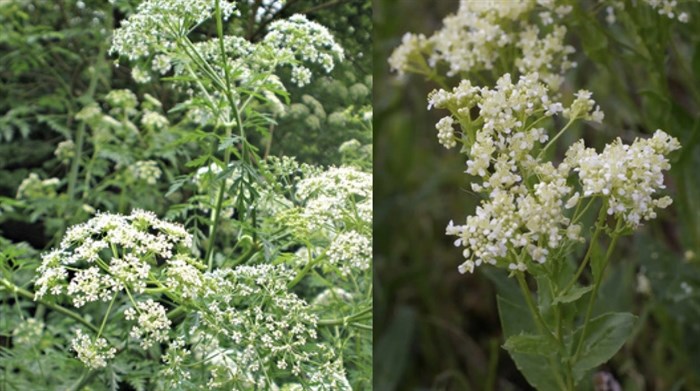
Poison hemlock on the left, and hoary cress on the right.
Image Credit: Ansel Oommen, Bugwood.org - BStewart vis ISCBC
May 18, 2024 - 12:00 PM
As the weather warms up a non-profit organization is urging the public to watch out for invasive plants in Columbia Shuswap, including poison hemlock.
The Columbia Shuswap Invasive Species Society is a charitable non-profit dedicated to the prevention, reduction, and management of invasive species in the region, and they’re asking for the public’s help, according to a press release from the society.
This year there are two high priority invasive plants the society wants people to report sightings of; hoary cress and poison hemlock.
Hoary cress is one of the top 25 invasive plants in B.C., it can lower crop yields and ruin livestock products since it often spreads through hay and seeds.
“With the development of the Shuswap North Okanagan Rail Trail, this plant has a higher potential to spread into our region. It is important for everyone to keep an eye out for hoary cress,” the society’s field manager Laura Gaster said in the release.
Hoary cress grows between 10 and 60 cm tall, has blue-green arrow shaped leaves, small white flower clusters at the top of the stem, and two heart shaped seed pods per flower. The plant prefers sunny spots like meadows and pastures.
READ MORE: PULL THE PLUG: Transporting boats in BC with drain plugs in now illegal
The dangerous plant for individuals is poison hemlock. Poison hemlock is aptly named since it’s highly toxic and a small amount can kill people, livestock, and wildlife if ingested. The entire plant is poisonous and can cause skin reactions as well as respiratory problems.
Poison hemlock looks a lot like other plants in the Apiaceae family like carrots, parsnips, wild celery, and Queen Anne’s lace. It has tiny, white, five petaled flowers that form a broad umbrella shape. The leaves are bright green, triangular, and have a musty smell. The stems are hairless and have distinctive purple blotches.
Poison hemlock can produce up to 30,000 seeds per plant that can remain viable in the soil for 3 to 5 years.
If anyone spots either of these plants they can report them on the society’s website or use the Report Invasive app on their phone.
Click here for the society’s site.
To contact a reporter for this story, email Jesse Tomas or call 250-488-3065 or email the editor. You can also submit photos, videos or news tips to the newsroom and be entered to win a monthly prize draw.
We welcome your comments and opinions on our stories but play nice. We won't censor or delete comments unless they contain off-topic statements or links, unnecessary vulgarity, false facts, spam or obviously fake profiles. If you have any concerns about what you see in comments, email the editor in the link above. SUBSCRIBE to our awesome newsletter here.
News from © iNFOnews, 2024